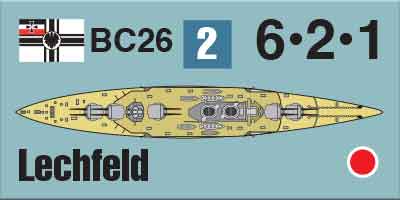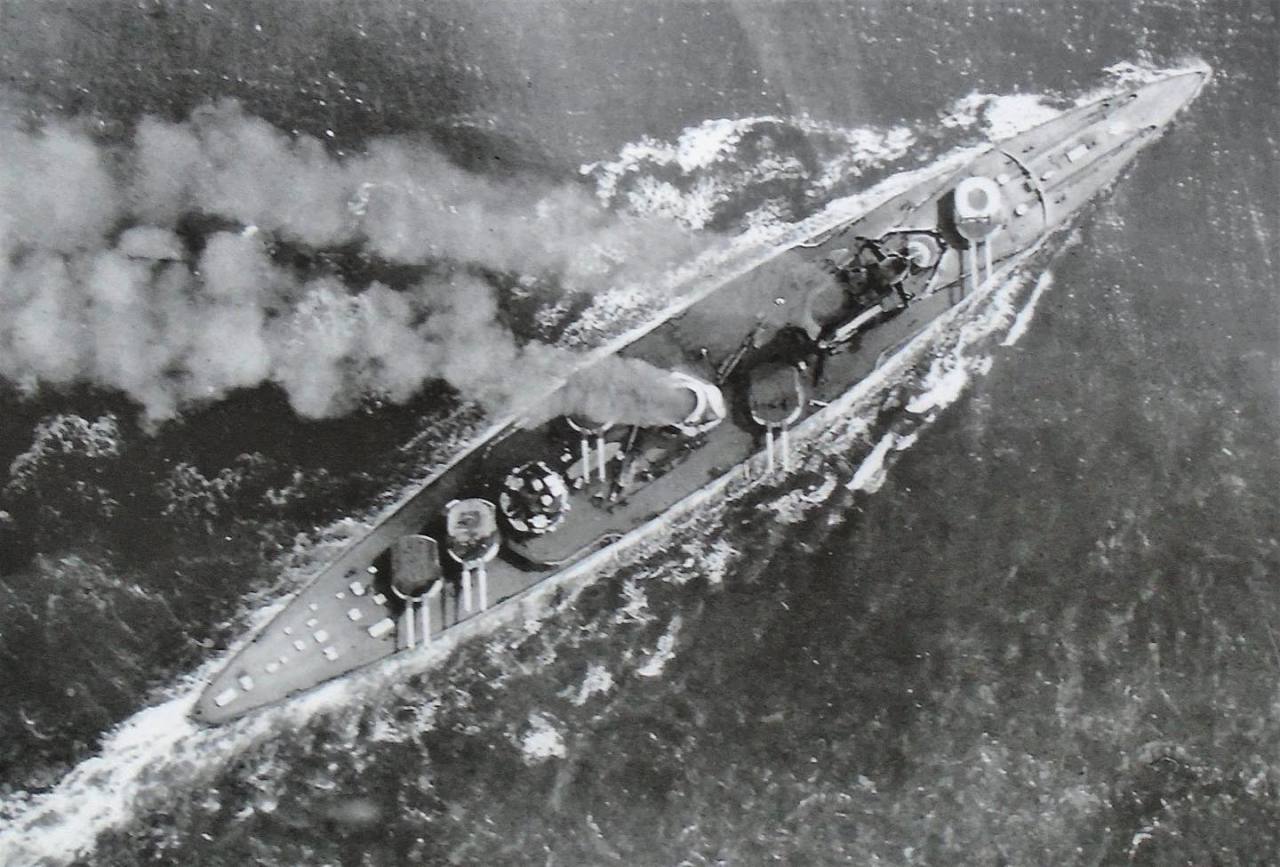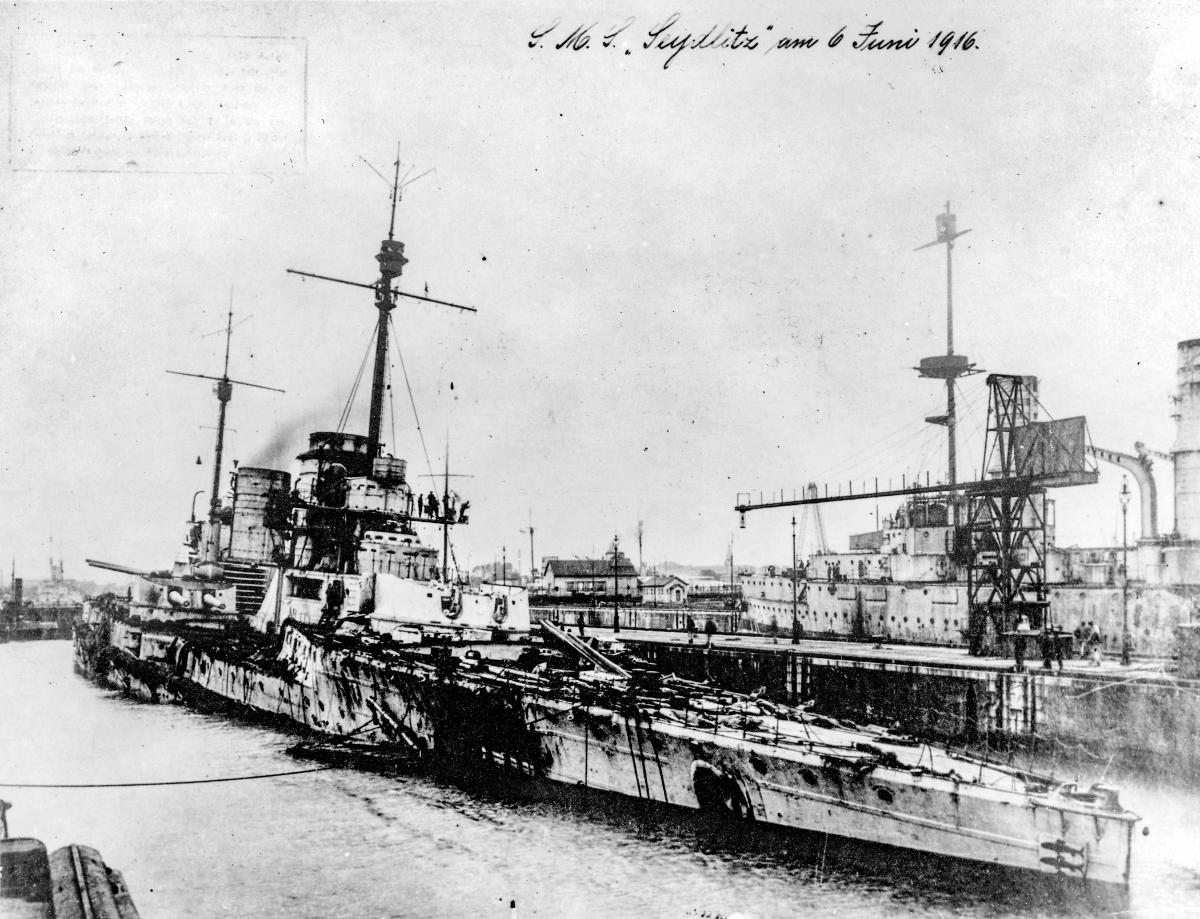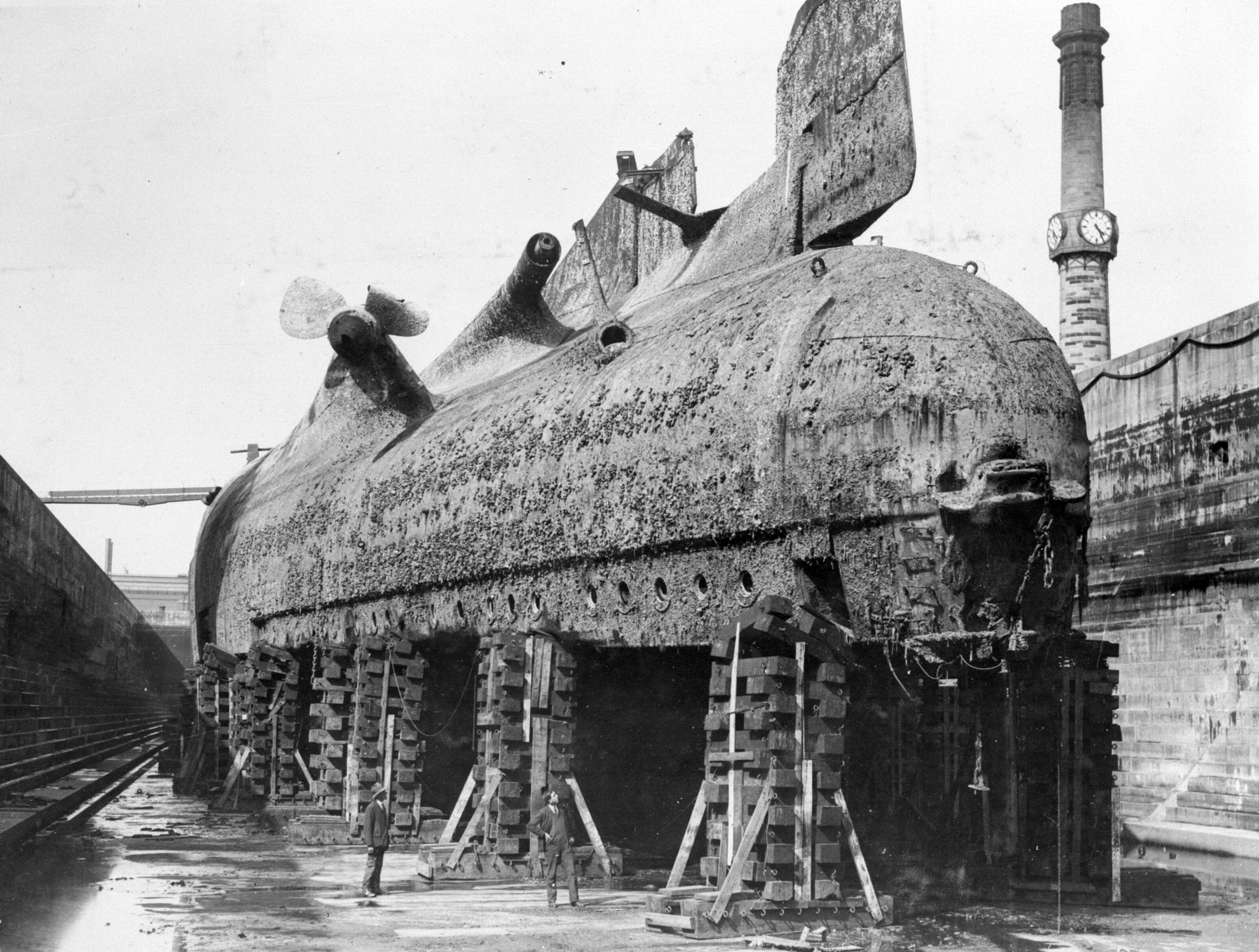| Jutland:
SMS Seydlitz
By Mike Bennighof, Ph.D.
February 2023
 Germany’s first five battle cruisers were built under the same authorization for the armored cruiser Blücher, that had allowed for six “great cruisers,” as the Imperial Navy called its armored and battle cruisers. As these represented an accession of strength rather than replacement of retired ships, the initially carried letter designations. Germany’s first five battle cruisers were built under the same authorization for the armored cruiser Blücher, that had allowed for six “great cruisers,” as the Imperial Navy called its armored and battle cruisers. As these represented an accession of strength rather than replacement of retired ships, the initially carried letter designations.
The fourth battle cruiser, Grosser Kreuzer J, would continue the German practice of building fast battleships that sacrificed armament for the ability to stand in the line of battle alongside the dreadnoughts. The Shipbuilding Section of the Naval Construction Department offered several alternative designs, three of which received serious consideration.
The previous three battle cruisers had carried 280mm (11-inch) guns, the same as the first class of German dreadnoughts. But subsequent dreadnoughts had moved to the 305mm (12-inch) gun, while the battle cruisers of the preceding Moltke class retained the smaller main battery. The new ship could not cost significantly more than the previous class, which greatly limited the room for improvement.
A slightly improved Moltke could fit within the budget fairly easily; thanks to some budgetary wizardry the new ship could displace about 1,000 tons more, which would allow for better protection. She would be slightly longer to compensate for the increased weight of the additional armor and to maintain her speed.
Another design study looked at replacing the five 280mm turrets with four twin turrets for 305mm guns, in a layout very similar to that of Germany’s first battle cruiser, von der Tann. Despite the loss of one turret, the weight of the larger turrets and the armored barbettes below them brought the ship over its displacement limit.

The third finalist retained the five twin turrets for 280mm guns, but placed them all on the centerline. That would allow all of them to fire on the broadside, and give the ship better protection as well as narrower lines, allowing for greater speed. But some objected to the loss of firepower astern – where the Moltke-derived ship could, in theory, fire directly astern with three turrets – and to the close grouping of two turrets forward and two aft, in super-firing pairs, as a single unlucky hit could knock out two turrets at once.
When the Navy’s State Secretary, Admiral Alfred von Tirpitz, convened his department heads to choose a design for the new great cruiser, he found them divided. Tirpitz himself favored the conservative design, the improved Moltke, and that would be the ship built for the 1910 budget year. Like all the preceding German battle cruisers, she was built at Hamburg’s Blohm & Voss yard.

Seydlitz, as she would be named, would carry the same 28cm SK L/50 rifles as the Moltke class, the same number of them (ten) in the same arrangement. Supplementing those were a dozen 15cm SK/45 guns, the same weapon found on nearly every German capital ship and many light cruisers of the period. She also carried a dozen 88mm light guns, but these would be removed during the course of the Great War and replaced by a pair of 88mm anti-aircraft guns. The casemates represented a weak point in the ship’s armor scheme and the light guns added nothing to her firepower. Like Moltke, Seydlitz carried four underwater torpedo tubes.
The main turrets differed slightly from the previous model, with thicker armor than those of Moltke. Seydlitz had the “honeycomb” approach to protection of other German heavy warships, with her armor thickened overall compared to Moltke. She would prove to be an extraordinarily tough ship.
Though considerably larger than Moltke, Seydlitz turned out to be slightly faster, thanks to more powerful machinery and finer lines. She initially had only coal-fired boilers, with a supplementary oil spray added in 1916 as coal quality declined throughout the war. Designed for 26 knots, she made 28 on trials in the summer of 1913, but never approached that mark during the war.
Seydlitz commissioned in May 1913; most of her crew came from the armored cruiser Yorck, which had just decommissioned. As Seydlitz required more men than Yorck, the remainder came form other High Seas Fleet ships; in time-honored fashion, those captains donated their malcontents and other undesirable. A few bar-room brawls instigated by the Yorck crew plus constant harassment resulted in large-scale requests for transfer, and Seydlitz received new recruits and newly-promoted ratings in their place.

Battle cruiser Seydlitz, overhead view.
As her first captain, Seydlitz drew Moritz von Egidy, the adjutant to Grand Admiral Prince Heinrich, the Navy’s inspector general (and the Kaiser’s brother). Egidy, the son of politically suspect social ethicist Moritz von Egidy and brother of feminist novelist Emmy von Egidy, certainly held different views than the typical German naval officer and owed his appointment to his high-powered patron. But he forged a very tight-knit crew, which would save the ship at both Dogger Bank and Jutland.
After completing trials, Seydlitz took Yorck’s place in the First Scouting Group, the heavy ships that supported the High Seas Fleet’s cruiser and torpedo boat screen. Seydlitz had been fitted as a squadron flagship, and Franz Hipper shifted his flag and about 70 staffers from Moltke to Seydlitz. For the next year she exercised with her squadron mates, and in the summer of 1914, plans began for a North American tour to celebrate the opening of the Panama Canal.
Once war broke out, Seydlitz saw constant activity, especially after the Battle of Helgoland Bight in late August 1914, when low tide prevented the German heavy ships from crossing the bar outside Wilhelmshaven in time to support the light cruisers patrols when they came under British attack. Afterwards the High Seas Fleet deployed its battle cruisers on coastal-defense duty, surely not the mission for which they had been intended. And like all of the battle cruisers, her turbines required near-constant dockyard attention.
Seydlitz participated in all of the First Scouting Group’s missions, suffering three hits from 6-inch shells fired by British coastal batteries during the bombardment of Hartlepool in December 1914. Repairs kept her out of service for four days, and she was fully ready for the Dogger Bank operation in January 1915.
Hipper’s flagship suffered three heavy shell hits at Dogger Bank. The first did no appreciable damage, but the second penetrated the battery deck and exploded against the armored barbette of Turret D, the aftmost heavy gun turret. While the armor held for the most part, the explosion punched a small hole in the barbette, sending a red-hot chunk of armor “spalled” by the impact into the working chamber, with catastrophic results. Charges being prepared for firing caught fire instantly, and flames shot down into the handling room below and up into the turret. Many of the crew died instantly, but others survived and tried to escape into the neighboring C Turret. When they opened the armored doors leading into C Turret’s handling room, the flames followed them.

Seydlitz comes home from the Battle of Jutland.
The aft part of the ship filled with blinding, toxic gasses, making it impossible to find the valves allowing the magazines to be flooded before they exploded. But Pumpmaster Wilhelm Heidkamp had been part of the cadre crew assigned to Seydlitz during her construction, and he found them by feel. Turning the red-hot wheel, he opened the first vale, but couldn’t get the second open once the flesh had burned off his hands. Fireman Franz Müller took over and got the seawater flowing to save the ship. But 165 men had died in the turrets.
“If we lose 190 men,” Egidy told his gunnery officer, “and almost the whole ship in accordance with regulations, then they are somehow wrong.”
The near-disaster brought a complete review of shell-handling procedures through the High Seas Fleet, which would save the ship again at Jutland. Failure to do the same led to three British battle cruisers exploding in the same battle.
Repairs lasted until April, and Seydlitz took part in several sorties into the North Sea before returning to Wilhelmshaven Navy yard for most of July to endure turbine repairs. After a September interlude in the Baltic Sea, it was back to North Sea probes until a new fleet commander, Reinhard Scheer, decided to provoke the Grand Fleet with the April 1916 bombardment of Lowestoft. Seydlitz struck a mine during the operation and remained under repair until late May; her return to service dictated the timing of the operation that led to the Battle of Jutland.
Only the superhuman efforts of Egidy’s crew brought Seydlitz back to Wilhelmshaven. She suffered 22 heavy shell hits during the battle: eight from 15-inch shells, six from 13.5-inch rounds, and eight more from 12-inch guns. Plus she was hit by one torpedo. The ship’s forward areas flooded, requiring counter-flooding of several aft compartments to keep her trim enough to make way. She limped home at 7 knots, having lost 98 men killed and 55 wounded.
This time repairs last for four months; Seydlitz returned to the First Scouting Group and spent the next year mostly on picket duty outside Wilhelsmhaven. In November the British attacked the patrols, but Seydlitz failed to sight the enemy, and continued patrolling until April 1918, when the High Seas Fleet finally made another sortie but did not encounter the British.

Seydlitz is prepare for scrapping. Rosyth, 1928.
The war ended in November 1918 with Seydlitz in Wilhelmshaven’s floating drydock. She went to Scapa Flow with the rest of the interned High Seas Fleet and was scuttled there in June 1919; her wreck was finally broken up in 1928.
For a conservative compromise, Seydlitz had given good value, thanks as much to Egidy’s crew-building skills as to the ship herself. Seydlitz had good protection for her time, but relatively weak armament. As a coal-fired ship, her speed became suspect once the High Seas Fleet lost access to high-quality English coal.
Order Jutland second edition here.
Please allow an extra three weeks for delivery.
Sign up for our newsletter right here. Your info will never be sold or transferred; we'll just use it to update you on new games and new offers.
Mike Bennighof is president of Avalanche Press and holds a doctorate in history from Emory University. A Fulbright Scholar and NASA Journalist in Space finalist, he has published a great many books, games and articles on historical subjects; people are saying that some of them are actually good.
He lives in Birmingham, Alabama with his wife, three children, and his new puppy. His Iron Dog, Leopold, could swim very well.
Want to keep Daily Content free of third-party ads? You can send us some love (and cash) through this link right here.
|
